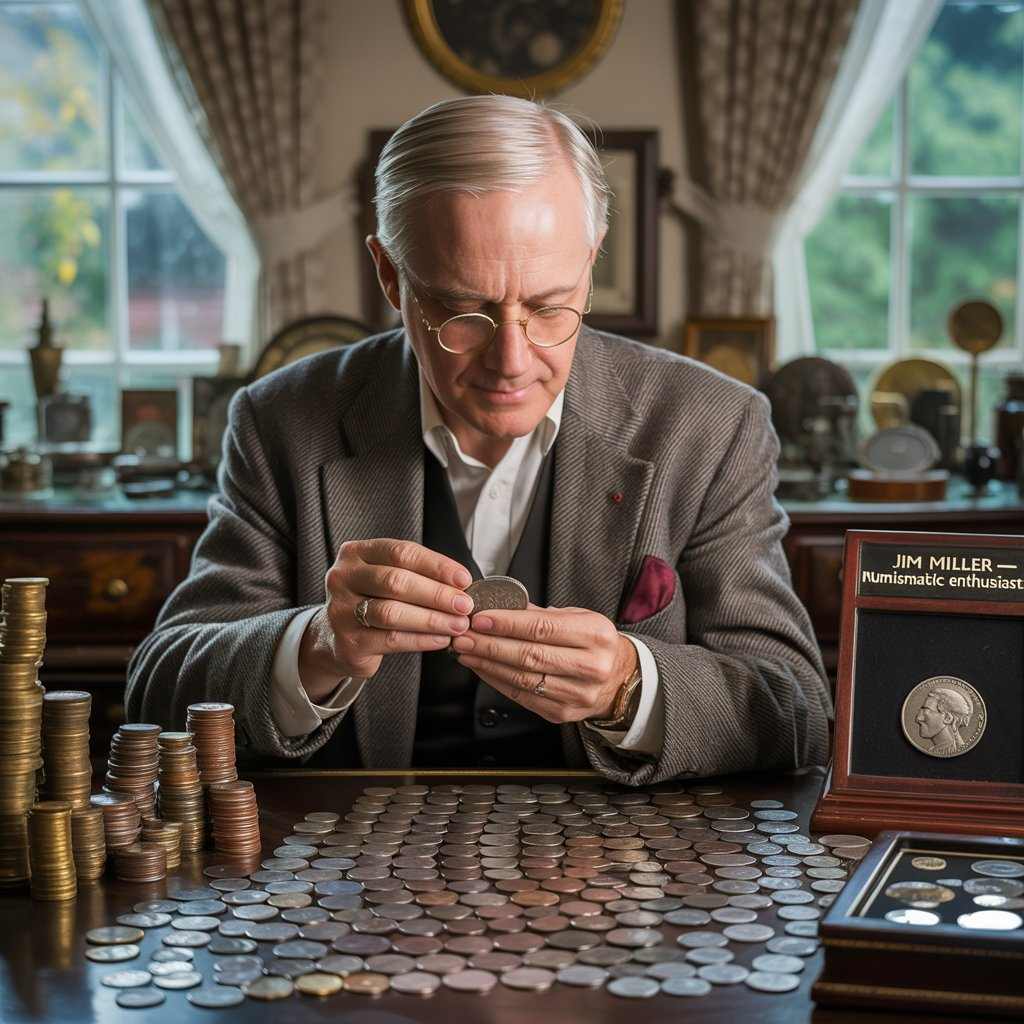
Jim Miller
About the Author
Jim is a keen numismatic enthusiast from a small town in Ohio. His passion began in childhood, when his grandfather gave him an old album with coins filled with history and memory. Jim has devoted more than 30 years to numismatics.
He is a member of the local numismatic club. There Jim shares his knowledge and experience with other collectors. He helped many aspiring coin collectors navigate the complex world of coins, and also participated in the evaluation of collections for local museums and historical societies.
Follow Jim on Social Media



Coins of 1964
The coins, minted in 1964, attract the attention of both novice and experienced collectors. And it’s not just their relative age. Estimating the value of these coins is an urgent topic today, because some copies may conceal unexpected value.
Why is this interesting?
- This is a transitional period in the coinage of the United States, when silver was gradually replaced by cheaper metals.
- Among the millions of coins issued, there are instances with rare errors that significantly increase their value.
History and details
- In 1964, the United States actively minted nickels (5 cents) with the image of Thomas Jefferson.
These coins were issued in huge quantities, but certain types and conditions can affect their value. Many people are wondering: are 1964 nickels worth anything? The answer depends on several factors, which we will consider further.
Material
It is important to know what nickels made of before 1964 are. Until 1964, nickels contained a certain percentage of silver.
However, the 1964 nickels no longer contain silver. They are minted from a copper-nickel alloy (75% copper and 25% nickel). The question is how much silver is in a 1964 nickel? The answer is no.
Production and features of the era
1964 was a turning point in the history of coinage in the United States. The sharp rise in silver prices led to the fact that silver coins began to disappear from circulation, as people began to save them.
This prompted the government to switch to cheaper alloys. This period is typical for these and the search for rare things, such as valuable nickels 1964.
It is also important to remember the existence of the 1964 nickel error list with pictures.
Minting errors, such as a double strike, misalignment, or missing mint mark, can significantly increase the value. Therefore, careful study of each instance can bring unexpected rewards.
How much is a nickel from 1964 worth?
In most cases, a 1964 nickel costs only a nominal value of 5 cents. However, copies in perfect condition or with rare errors can cost much more, up to several tens or even hundreds of dollars.

1964 Nickel Error List
| Coin name | Value | Description | Features |
|---|---|---|---|
| D Silver Nickel Error | $30-$150 | A rare misspelled coin issued with silver content, which is unusual for this year’s nickels. | Shiny surface, silver tint, sometimes a “double” impression on the reverse or obverse. |
| No Mint Mark Double Die | $100-$500 | Double Die error on coins without mint mark. It is very rare and valuable among collectors. | Bifurcation of letters and numbers on the obverse or reverse, a distinct stamped “shadow”. |
| D RPM (Repunched Mint Mark) | $50–$200 | A coin with a re-stamped “D” mark from the Denver Mint. | There is a noticeable “blurring” or bifurcation of the letter “D”, sometimes an outline in the form of a shadow. |
| Wrinkled Die | $40-$120 | An error related to a crumpled or damaged die, which causes wrinkled, distorted reliefs on the surface of the coin. | A pronounced textural defect, especially clearly visible on the portrait obverse. |
| Special Strike | $25-$200 | Coins issued not for regular circulation, but as special issues (proof coins or limited edition). | Mirrored background, matte portrait, high contrast. |
| Copper-Nickel with Die Clash | $30-$100 | Coins with an error in the form of a “collision” of stamps — when the obverse and reverse hit each other without a coin between them. | Unusual prints, ornaments, and lines unusual for ordinary coins on the reverse or obverse. |
| Error Coins with Die Breaks | $50-$250 | Rare coins with die breaks — cracks, chips and cracks on the die, which give the coin a unique relief. | Lines of cracks, deformations, and metal gaps are visually noticeable; often in the form of protrusions or depressions in the relief. |
| Jefferson Nickel No Mint Mark High Grade | $10-$100 | A 1964 coin without a mint mark, belonging to the Jefferson Nickel series. | The absence of a “D” or “S” mark means that the coin was minted at the Philadelphia Mint, which did not stamp at that time. |
What Makes It Valuable
In most cases, things such as the 1964 Jefferson nickel have a value that does not exceed a few dollars. This is due to the fact that they were released in large numbers and are not particularly valuable to collectors.
- For example, a regular 1964 nickel without any unique features or errors may cost only a nominal value or a little more.
Rare errors and versions
- However, there are exceptions among the 1964 coins. Rare bugs and different versions can greatly enhance their value.
- The 1964 nickel D mint mark on back may be more valuable if it contains rare minting errors. Collectors are hunting for such specimens, and their value can rise to significant amounts on the market.
Influence of the condition (span, XF, BU)
The condition of it also plays a key role in determining its value. They are classified by condition, as Span (Good), XF (Extremely Fine) or BU (Brilliant Uncirculated).
- The better the condition, the higher its value. The valuable 1964 nickel value today may vary depending on whether it is in BU condition or has visible signs of wear.
To estimate the value of a particular thing, such as the 1964 Jefferson nickel no mint mark or other variants, it is important to consider all of the above factors.
1964 Nickel Error List With Pictures
1964 D Silver Nickel Error
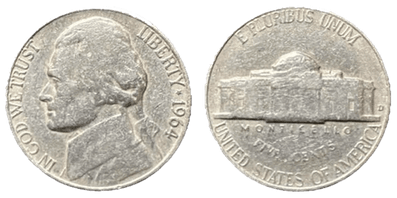
This is a unique and rare thing that attracts the attention of collectors and numismatists. Released in 1964 at the Denver Mint, it is an interesting example of a mistake in the manufacturing process.
Usually, 1964 nickels do not contain silver, which makes this it especially valuable.
It is important to remember that the question is where is the mint mark on a 1964 nickel – if it’s minted in Philadelphia, then there will be no mint mark.
Materials and characteristics
It’s made of an alloy containing 35% silver and 65% copper. Visually, the 1964 nickel silver has a shiny surface and a silvery hue, which distinguishes it from other nickel coins.
Errors and their meaning
- Among the features of errors that can occur on this, there are variants with high silver content due to lining or improper metal processing.
- Sometimes you can see double impressions on the obverse or reverse, which also adds interest to this.
- Given the variety of possible options, the value of 1964 nickel can vary in a wide range.
Value
Depending on the condition of it and the authenticity of the silver, coins in the “Brilliant Uncirculated” state may cost more, as collectors are willing to pay for copies that are in perfect condition.
The lack of a mint mark on the Philadelphia coin affects the 1964 nickel no mint mark value, but not always in the upward direction – it all depends on the rarity and condition of the specimen.
1964 No Mint Mark Double Die Nickel
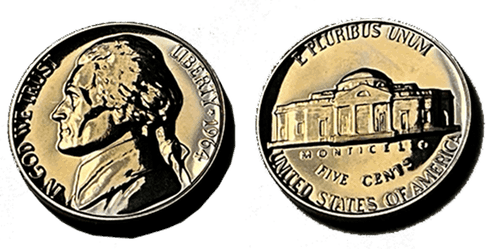
The year 1964 became a landmark year for collectors, especially with the introduction of a valuable rare 1964 nickel-marked.
This double mistake is found on coins issued without a mint mark, which makes them especially attractive to numismatists. This feature distinguishes it from the usual 1964 no mint mark nickel.
Errors and visual features
- The main feature of this coin is the double minting error, which manifests itself in the form of bifurcation of inscriptions, dates or images.
- On the obverse, you can see Jefferson’s double profile or double-digit numbers in the date.
- These visual effects, such as the distinct “shadow”, make each coin unique and emphasize its value.
- The double-strike coin is undoubtedly a kind of 1964 nickel special strike, different from regular copies. It is these features that directly affect the 1964 no mint mark nickel value.
Additional point
Coin minting errors are the subject of active search among collectors, which makes them not only interesting to study, but also profitable to invest in.
Studying these coins, especially those that do not have a mint mark, allows you to better understand the process of minting coins of that time and appreciate the uniqueness of each copy.
1964 D RPM (Repunched Mint Mark) Nickel
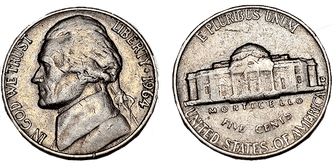
The 1964 coin with the re-embossed “D” sign is of interest to collectors because it demonstrates an error that gives it uniqueness and value. This error occurs when a mark is punched twice on the mint stamp, which leads to misalignment or overlapping of the images.
1964 nickel mint mark location
It is depicted on the reverse, at the bottom right, under the mountain peaks. This makes it easily recognizable and distinguishes it from other coins of that time. Such variations and errors only emphasize that not all 1964 nickels worth money are equal, and the rarity directly affects the price.
Value
- The price range for DRM 1964 is from 50 to 200 dollars and above, depending on the brightness of the error and the general condition of the coin.
- Specimens with a pronounced error can reach significantly higher prices at auctions, which makes them attractive to collectors.
- It is worth noting that the usual 1964 no mint mark nickel (without the mint stamp), although interesting in itself, is significantly inferior in price to a similar defective coin.
Additional point
Errors on coins can occur for various reasons, including worn stamps or incorrect installation, and each of them has its own story. While the 1964 no mint mark nickel value is usually not high for circulating copies, coins with errors like DRM show how valuable deviations from the norm can be.
1964 Wrinkled Die Nickel
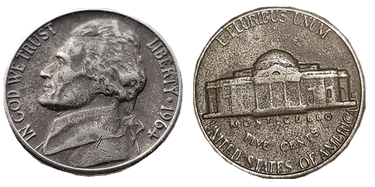
There is a characteristic error on the coin due to a damaged stamp. This error leads to the appearance of wavy and distorted reliefs on the surface of the coin, which makes it especially interesting for numismatists. It is made of 1964 copper nickel.
Error and visual features
- The Wrinkled Die error occurs due to crumpling or damage to the die, which leads to the formation of wrinkled reliefs.
- On the obverse, where the portrait of President Thomas Jefferson is depicted, wavy, uneven areas are clearly visible.
- These “wrinkles” can manifest as textural defects, sometimes with “tears” or waves in the field around the profile.
- Especially pronounced defects make this coin noticeable among other copies of 1964.
Value
The score depends on the severity of the defect: the more pronounced the texture defect, the higher the value of the coin. Specimens with pronounced wrinkles and minimal signs of wear can reach higher prices at auctions.
Additional points
- Coins with minting errors, such as the 1964 Wrinkled Die Nickel, are often of interest not only to collectors, but also to investors seeking to acquire unique items.
- Errors related to damaged stamps can occur for various reasons, including improper handling of tools at the mint or wear and tear of equipment.
Each such mistake has its own story, which adds value and interest to each particular coin.
1964 Special Strike Nickel

This is a unique coin, issued in 1964 as part of a special issue.
These coins were not intended for regular circulation and were created in limited quantities, which makes them especially attractive to collectors.
They belong to the category of proof coins, which implies special care in the process of their minting.
Features and visual characteristics
- The main difference between the 1964 Special Strike Nickel is its high detail and mirrored surface.
- The coins are stamped on specially prepared blanks, which ensures their exceptional quality.
Value
- Excellent specimens with pronounced characteristics can reach even higher prices at auctions.
- Coins that are 1964 nickel with no mint mark are especially appreciated, as the absence of a mint mark makes them more rare and desirable for collectors.
Additional points
Special Strike type coins are often used as gift or anniversary items, which adds additional value to them.
Some collectors prefer to collect complete sets of proof coins for certain years, and the 1964 Special Strike Nickel is an important element of such collections.
1964 Copper-Nickel with Die Clash
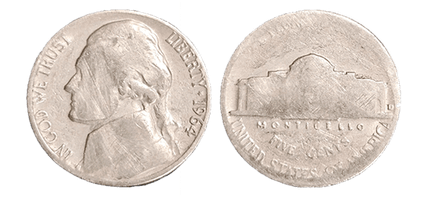
This error occurs when the obverse and reverse of a coin collide with each other without an intervening disk, leaving unusual prints on the surface. Such copies belong to the error coin 1964 nickel category and are a valuable addition to any collection.
Error and visual features
- The main characteristic of this coin is the presence of a “collision” of stamps, which leads to the appearance of unusual prints of elements of one side on the other.
- On the obverse, you can see light stamped spots and lines that are unusual for standard coins.
- These visual effects make each coin unique, as the severity of errors can vary. For example, the clarity and brightness of the prints can significantly affect the valuation of a coin.
Additional points
- Coins with errors such as this one are often the subject of discussion among numismatists, as each of them tells its own story about the production process and the mechanisms of minting.
- Despite the fact that 1964 was the last year of the silver nickel issue, the copper-nickel alloy continued to be used for other coins, which makes this mistake particularly interesting to study.
- Some collectors specialize exclusively in finding and acquiring error coin 1964 nickel, aiming to collect a complete set with various types of errors.
Rare 1964 Error Coins with Die Breaks
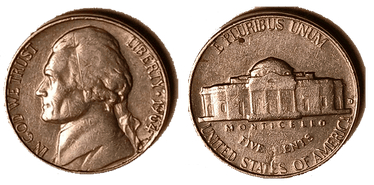
The 1964 coins with die breaks stamp damage are unique specimens that attract the attention of collectors due to their distinctive visual features. These rare coins have cracks, chips and other deformations on the matrix, which gives them a unique relief.
Errors and visual features
- Irregularities and cracks can be located along the edges of the relief details or on part of the coin’s field, creating an effect that significantly distinguishes such specimens from the standard 1964 no mint nickel.
- These visual defects not only make the coin interesting for collectors, but also emphasize the uniqueness of each individual coin.
Value
Especially valuable specimens are those with clearly visible defects and pronounced cracks. Collectors are often willing to pay a high price for rare 1964 nickel errors, as they become not only part of their collection, but also a source of pride.
Additional point
Die breaks coins can be associated with historical events: in 1964, significant economic and cultural changes took place in the United States, making these coins not only collectible items, but also historical artifacts.
1964 Jefferson Nickel No Mint Mark High Grade
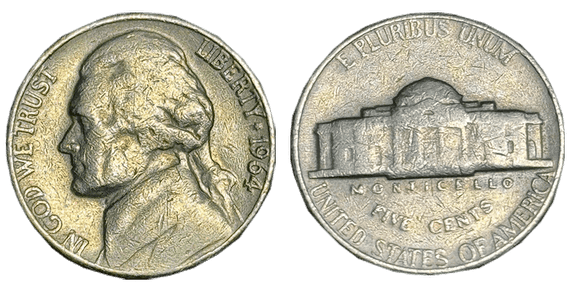
The interest in 1964 nickels goes beyond their face value, attracting collectors for various reasons. The early and mid-1960s, often referred to as the silver nickel years 1964, marked a turning point in U.S. coin minting. And although the Jefferson nickel of that year is mostly not silver, the minting volumes and variants make it attractive for collecting.
The 1964 coin without the mint stamp is a Jefferson nickel, which was minted at the Philadelphia Mint. It is of interest to collectors due to its high quality and the absence of a stamp, which makes it more rare.
Visual characteristics
- The coin is in excellent condition (mint condition, MS), characterized by purity and high relief.
- There are no scratches, stains or signs of wear on the surface.
- The metallic luster remains almost at the level of the new coins, which makes it an outstanding piece for the collection.
Additional points
- The Jefferson Nickel coin was designed by renowned sculptor Joseph W. Wilson (McCarthy), who depicted Thomas Jefferson’s profile on the obverse and his house in Monticello on the reverse.
- The question of the 1964 nickel value no mint mark is always relevant among collectors. The value depends on the safety of the coin and the rarity of the specimen.
- Although 1964 nickel silver content is insignificant (mostly copper and nickel), the year itself has historical value. Nevertheless, well-preserved copies without a mint mark, especially in MS condition, are always valued higher.